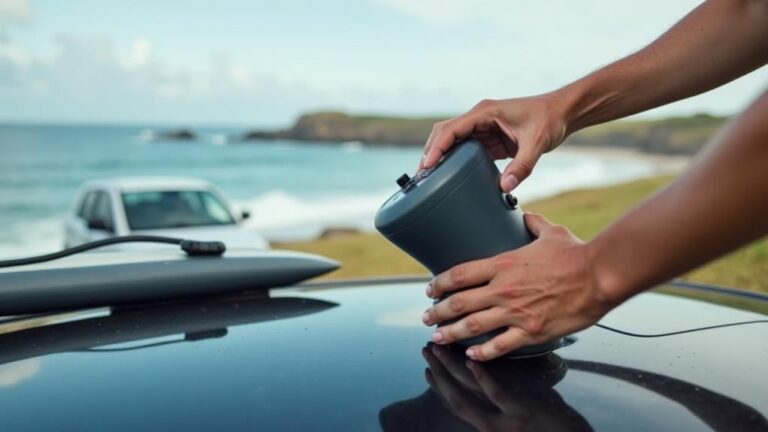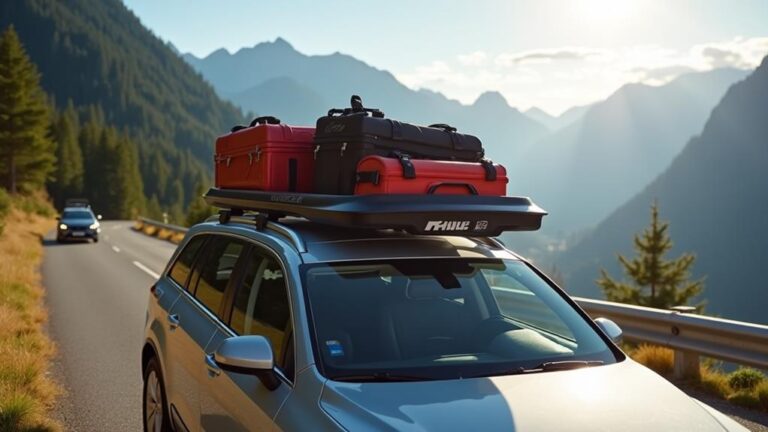As you stand at the crossroads, much like the ancient traveler in Robert Frost's famous poem, you're faced with a decision: to buy a Seasucker or not. But before you take that first step, it's vital to understand what you're getting into. You see, a Seasucker is more than just a product â€" it's a promise of a secure and reliable bond between your gear and the surface it's attached to. But can it deliver? What are the key features you should be looking for, and what are the limitations you need to be aware of? The answers lie just ahead.
Key Takeaways
- Determine the suction power needed for your specific surface type and weight requirements.
- Ensure the Seasucker is compatible with the surface material and texture you'll be using it on.
- Check the weight capacity and load testing guidelines to avoid overloading the product.
- Assess the durability and quality of the Seasucker's materials and construction.
- Consider the portability, storage, and accessories needed for your specific use case.
Key Features of Seasucker
As you ponder purchasing a Seasucker, one of the most vital factors to assess is its key features.
This will help you determine if it's the right tool for your marine adventures. The Seasucker is a vacuum-mounted device that relies on suction power to attach to surfaces, so understanding its key features is vital.
The suction power of a Seasucker is a pivotal element to ponder.
It's measured in pounds per square inch (PSI) or kilopascals (kPa), and ranges from around 5-12 PSI (34-83 kPa) for different models. This determines the maximum weight the Seasucker can hold and the type of surfaces it can attach to.
For example, a higher suction power is required for rough or porous surfaces.
When evaluating the key features of a Seasucker, also ponder the size and weight of the device, as well as its material and construction.
The Seasucker's size and weight will impact its portability and ease of use, while its material and construction will affect its durability and corrosion resistance.
Attachment Systems Explained
When evaluating Seasucker's attachment systems, you'll encounter various types of suction cups designed for specific applications, such as flat or curved surfaces.
You'll also have mounting system options to choose from, allowing you to customize the setup to fit your needs.
At the core of Seasucker's attachment systems is their vacuum seal technology, which creates a strong and reliable bond between the suction cup and the surface it's attached to.
Types of Suction Cups
Within the Seasucker lineup, you'll find multiple types of suction cups designed to cater to specific needs and applications.
These cups are constructed from various materials, such as stainless steel, aluminum, and polyurethane, each with its unique strengths. Stainless steel cups are corrosion-resistant and suitable for harsh marine environments, while aluminum cups are lightweight and often used for freshwater applications. Polyurethane cups are versatile and offer excellent grip on smooth surfaces.
Seasucker suction cups also employ different suction mechanisms. Some models feature a hook-style mechanism, which allows for easy attachment and detachment.
Others utilize a lever-activated system, providing a secure grip on the surface. The vacuum pump-style mechanism is also available, offering high suction power and durability.
When choosing a Seasucker suction cup, consider the surface type, load capacity, and environmental conditions to select the most suitable cup material and suction mechanism for your needs. By understanding the characteristics of each suction cup type, you can make an informed decision and guarantee a secure attachment.
Mounting System Options
You'll find various Seasucker mounting system options, each designed to provide a secure and stable attachment for your gear.
These mounting options cater to different needs and preferences, allowing you to choose the one that best suits your equipment and vehicle.
Seasucker offers a range of mounting systems, including fixed mounts, adjustable mounts, and rail mounts, among others.
Each system is designed to provide a secure and stable attachment, ensuring your gear is safely held in place.
When selecting a mounting system, consider the type of gear you'll be attaching, as well as the surface it will be attached to.
For example, if you'll be attaching a bike rack to a car with a smooth surface, a fixed mount may be suitable.
However, if you'll be attaching a kayak to a vehicle with a textured surface, a rail mount may be more suitable.
You can also opt for custom installations, which allow you to tailor your mounting system to your specific needs.
Custom installations provide a seamless integration with your vehicle, ensuring a secure and stable attachment for your gear.
Vacuum Seal Technology
Seasucker's vacuum seal technology is the backbone of its attachment systems, relying on a combination of suction and a specialized rubber compound to create a secure bond between the mount and the surface. This technology enables you to attach your gear to various surfaces, including cars, boats, and RVs. The vacuum seal technology works by creating a partial vacuum between the mount and the surface, which generates a strong adhesive force.
To give you a better understanding of Seasucker's vacuum seal technology, a comparison of their products' seal strength and suction power is provided:
| Product | Seal Strength (psi) | Suction Power (inHg) |
|---|---|---|
| Mini Bomber | 210 | 27.5 |
| Gecko Handheld | 120 | 18 |
| Long Arm Bomber | 240 | 30 |
| Super Strong | 260 | 32.5 |
| Talon | 300 | 35 |
The table above shows the varying levels of seal strength and suction power for different Seasucker products. As you can see, the products with higher suction power tend to have stronger seal strength. When choosing a Seasucker product, consider the weight and size of the gear you'll be attaching to guarantee you select a product with sufficient seal strength and suction power.
Surface Compatibility Guide
Mounting a Seasucker vacuum cup requires a good understanding of the surface it'll be attached to.
Different surface types respond differently to the vacuum seal technology, and some may not be compatible at all. It's vital to test the material before applying the Seasucker to guarantee a strong and reliable bond.
When evaluating surface compatibility, consider the following factors:
- Material texture: Smooth surfaces tend to work best with Seasuckers, while rough or porous surfaces may not provide a secure seal.
- Material type: Glass, fiberglass, and most metals are compatible with Seasuckers, but some plastics and woods may not be suitable.
- Surface cleanliness: Verify the surface is free of dirt, oils, and other contaminants that could compromise the seal.
Conducting material testing before using your Seasucker can save you time and frustration in the long run.
By understanding the surface you're working with, you can guarantee a safe and reliable installation.
Remember to always follow the manufacturer's guidelines and recommendations for surface preparation and testing.
Weight Capacity and Limits
Determining the weight capacity and limits of your Seasucker setup is essential to guaranteeing safe and reliable performance.
When it comes to using Seasucker products, you need to ponder the maximum weight each unit can handle.
Load testing is a pivotal step in evaluating the performance of your Seasucker setup.
This process involves applying a load to the product while it's attached to the surface to verify it can withstand various weights.
Seasucker products are designed to provide a strong suction strength that can hold a significant amount of weight.
However, it's imperative to follow the manufacturer's guidelines to avoid overloading the product.
Overloading can lead to a decrease in suction strength, potentially causing the product to detach from the surface.
You should also ponder factors such as surface type, temperature, and humidity, as these can affect the performance of your Seasucker setup.
Durability and Construction
When it comes to Seasucker products, durability and construction play a crucial role in guaranteeing their long-term performance.
You'll want to ponder the material quality and build strength of the product to certify it can withstand various environmental conditions and heavy use.
Seasucker products are made with high-quality materials that are designed to last.
The construction of these products is also built to withstand heavy use, making them a great investment for those who plan to use them frequently.
- Material selection: Seasucker products are made from high-quality materials that are resistant to corrosion, UV damage, and other environmental stressors.
- Build strength: The build strength of Seasucker products is designed to withstand heavy use and harsh environmental conditions, certifying that they'll last for a long time.
- Quality control: Seasucker products undergo rigorous quality control tests to certify that they meet the company's high standards for durability and construction.
Portability and Storage Options
With Seasucker products built to withstand heavy use and harsh environments, you're likely to take them on the go, which makes portability and storage options a key consideration.
When evaluating Seasucker products, consider the weight and size of the product, as well as any travel cases or storage bags that may be included or available for purchase.
Travel cases can provide added protection and organization, making it easier to transport your Seasucker product from one location to another.
Seasucker products often feature quick releases, which allow you to quickly detach and reattach the product from your vehicle or other surface.
This feature can be particularly useful when storing or transporting your Seasucker product, as it eliminates the need to remove any permanent mounts or hardware.
Additionally, quick releases can help prevent damage to your vehicle or other surfaces, as they allow you to easily remove the product when not in use.
Additional Accessories Needed
Several additional accessories are available to complement your Seasucker product, and you'll likely need at least a few of them to get the most out of your purchase.
These accessories can enhance the functionality, performance, and overall user experience of your Seasucker.
To guarantee you have everything you need, consider purchasing accessory bundles or customized kits specifically designed for your product.
These bundles often include essential items, such as:
- *Mounting hardware* for securing your Seasucker to different surfaces
- *Power supply kits* to keep your device charged on the go
- *Protective cases* to safeguard your Seasucker from damage and wear
Accessory bundles and customized kits can be a cost-effective and convenient way to get all the necessary accessories at once.
They're also a great option if you're not sure which individual accessories you'll need.
Maintenance and Care Tips
To keep your Seasucker in prime working condition, you'll want to establish a regular maintenance routine that includes cleaning the vacuum mount, storing the device properly, and performing daily inspections.
You'll need to clean the vacuum mount regularly to remove dirt and debris that can affect suction power.
Cleaning the Vacuum Mount
Cleaning the vacuum mount on a regular basis is essential for peak performance and longevity of your Seasucker.
A dirty vacuum mount can lead to reduced suction power, making it harder to create a strong seal. To prevent this, you should clean the vacuum mount regularly.
- Use soft brushes to gently sweep away any debris or dirt that may have accumulated on the surface of the vacuum mount.
- Dampen a soft cloth with water and use it for gentle wiping. This will help remove any stubborn dirt or grime that may be present.
Avoid using harsh chemicals or abrasive cleaners, as these can damage the vacuum mount's surface or compromise its sealing ability.
When cleaning the vacuum mount, make sure to inspect it for any signs of wear or damage.
If you notice any cracks or damage, it's best to replace the vacuum mount to guarantee top-notch performance.
By following these cleaning tips, you can help maintain your Seasucker's performance and extend its lifespan.
Regular cleaning is key to getting the most out of your investment.
Seasucker Storage Tips
To maximize storage space, consider the Seasucker hacks of using a protective case or bag.
These cases not only shield the device from dust and debris but also prevent accidental damage.
When storing the Seasucker, avoid exposing it to extreme temperatures, direct sunlight, or moisture. This will help preserve the device's rubber seals and guarantee peak performance.
For peak suction, it's vital to store the Seasucker with the suction cup facing upwards.
This Suction secret helps prevent the buildup of dust and debris on the suction cup, guaranteeing a strong seal when you need it.
Daily Inspection Routine
Regular maintenance is essential for peak Seasucker performance, and it starts with a daily inspection routine.
As you prepare to use your Seasucker, you'll want to perform a series of checks to guarantee everything is in working order.
This daily inspection routine is pivotal for Safety checks and to maintain the Marine prep of your equipment.
- Check the vacuum seal for any signs of damage or wear. Make sure the seal is clean and free of debris to guarantee proper suction.
- Inspect the vacuum pump for any blockages or corrosion. Check the hoses for any damage or kinking, and guarantee all connections are secure.
- Verify that the Seasucker is properly installed and secured to the surface, and that all straps and hardware are in good condition.
Frequently Asked Questions
Can I Use Seasucker on a Fiberglass Boat With a Gelcoat Finish?
You can use Seasucker on a fiberglass boat with a gelcoat finish, but verify the surface is clean, dry, and free of contaminants to maintain fiberglass compatibility and gelcoat protection, preventing damage or adhesion issues.
Are Seasucker Products Compatible With All Types of Roof Racks?
You're charting new waters with Seasucker products. Before installing, consider roof rack styles and Crossbar compatibility – Seasuckers work seamlessly with round, square, and most aerodynamic crossbars, but may require adapters for specific rack systems.
Do I Need Any Special Tools for Installation and Removal?
You'll need basic tools for Seasucker installation and removal. Certify you have a good torque wrench for secure mounting. Tool quality matters, as it impacts installation prep and the overall stability of the system.
Can I Purchase Replacement Parts for My Seasucker Product?
You can purchase replacement parts for your Seasucker product, ensuring part availability. Regular suction maintenance is also vital; check the manufacturer's website or contact their support for compatible replacement parts and maintenance guidelines.
Does Seasucker Offer a Warranty or Return Policy?
You're likely seeking a safety net for your purchase. Fortunately, Seasucker offers a product guarantee and satisfaction assurance, providing a warranty that covers defects and a return policy for unwanted products, giving you peace of mind.
Conclusion
You've weighed the pros and cons, so now it's time to make an informed decision. Consider your needs, matching them to Seasucker's features and capabilities. Verify the product's durability and construction meet your standards, and its weight capacity and surface compatibility align with your requirements. By balancing functionality and portability, you'll find the perfect fit, taking your outdoor adventures to the next level with confidence and reliability.












